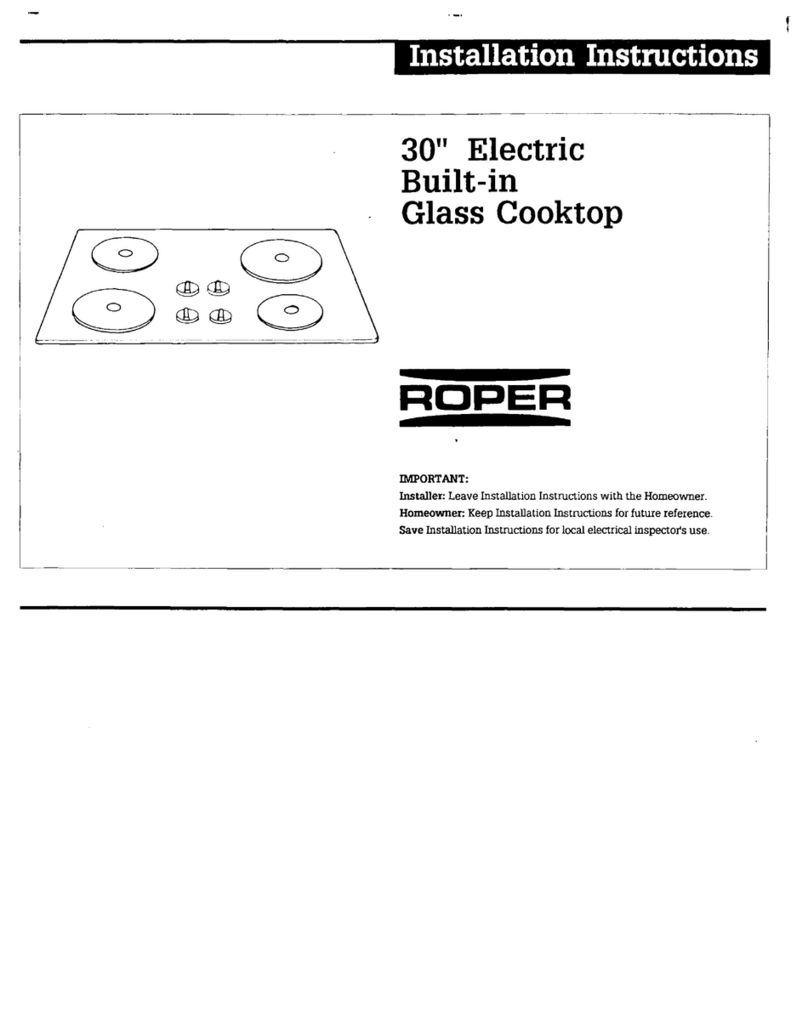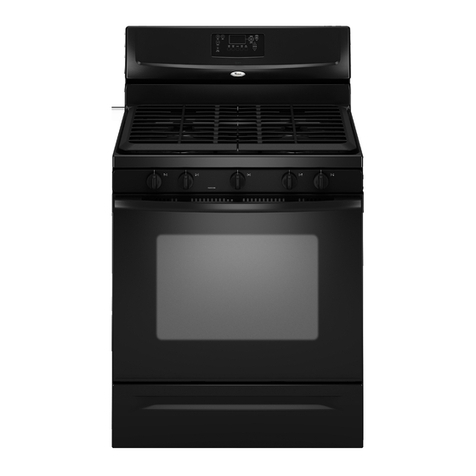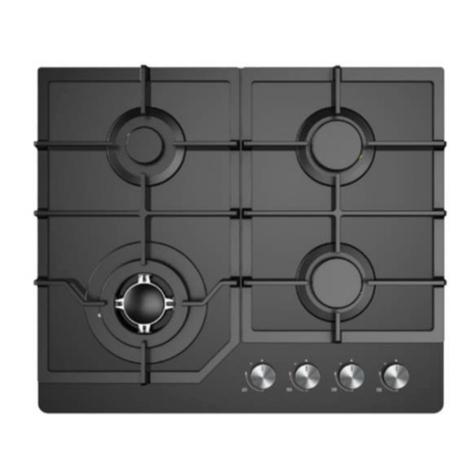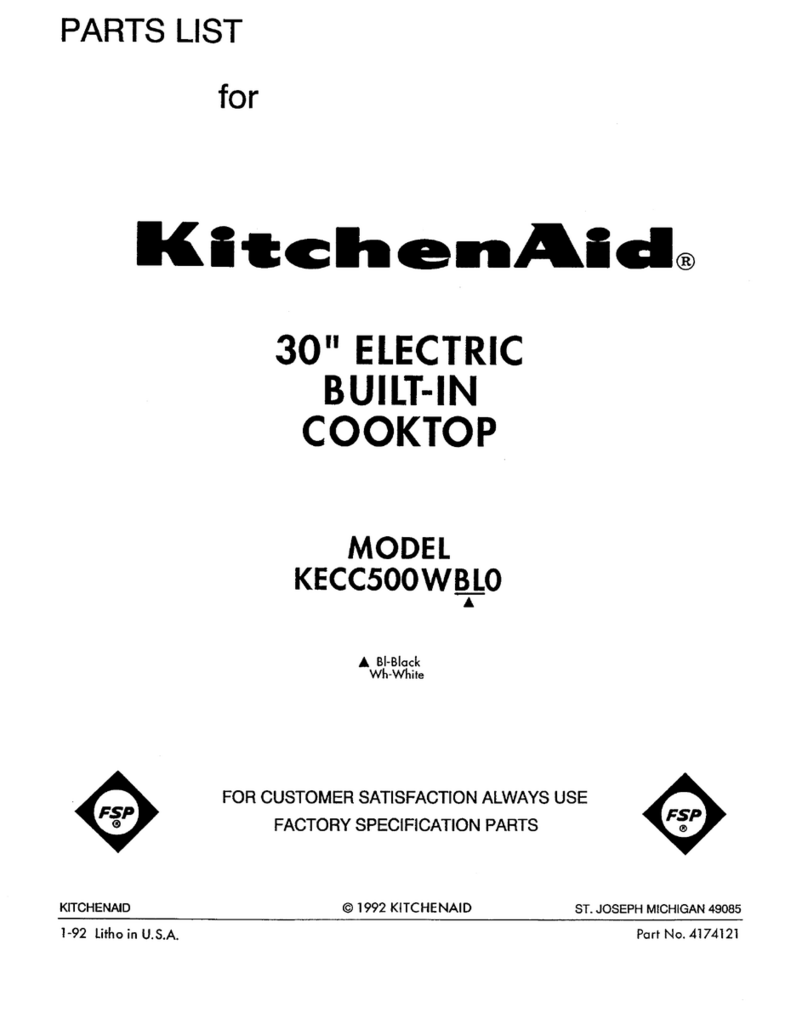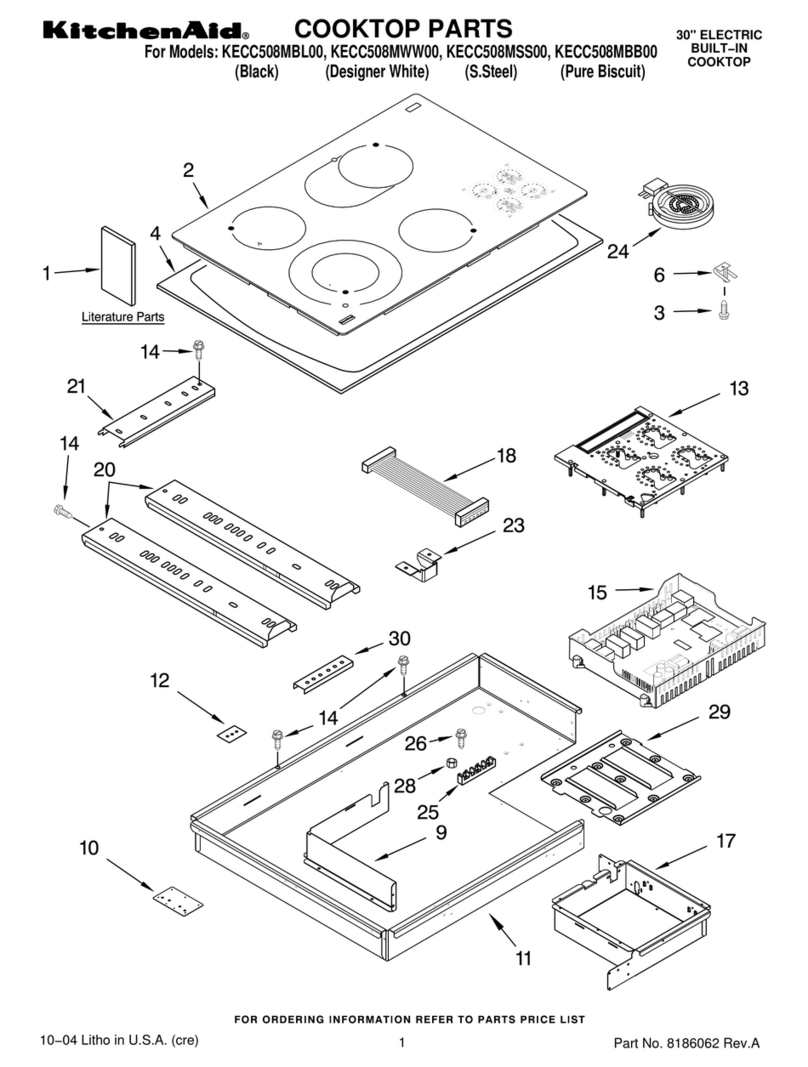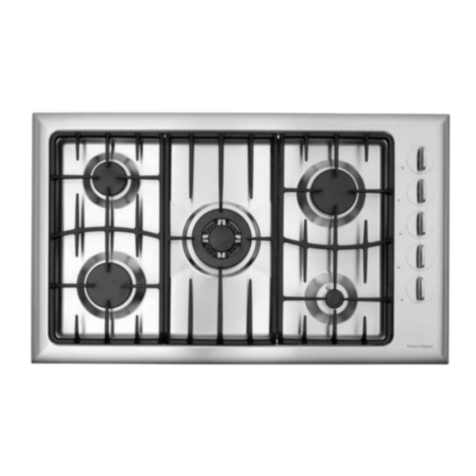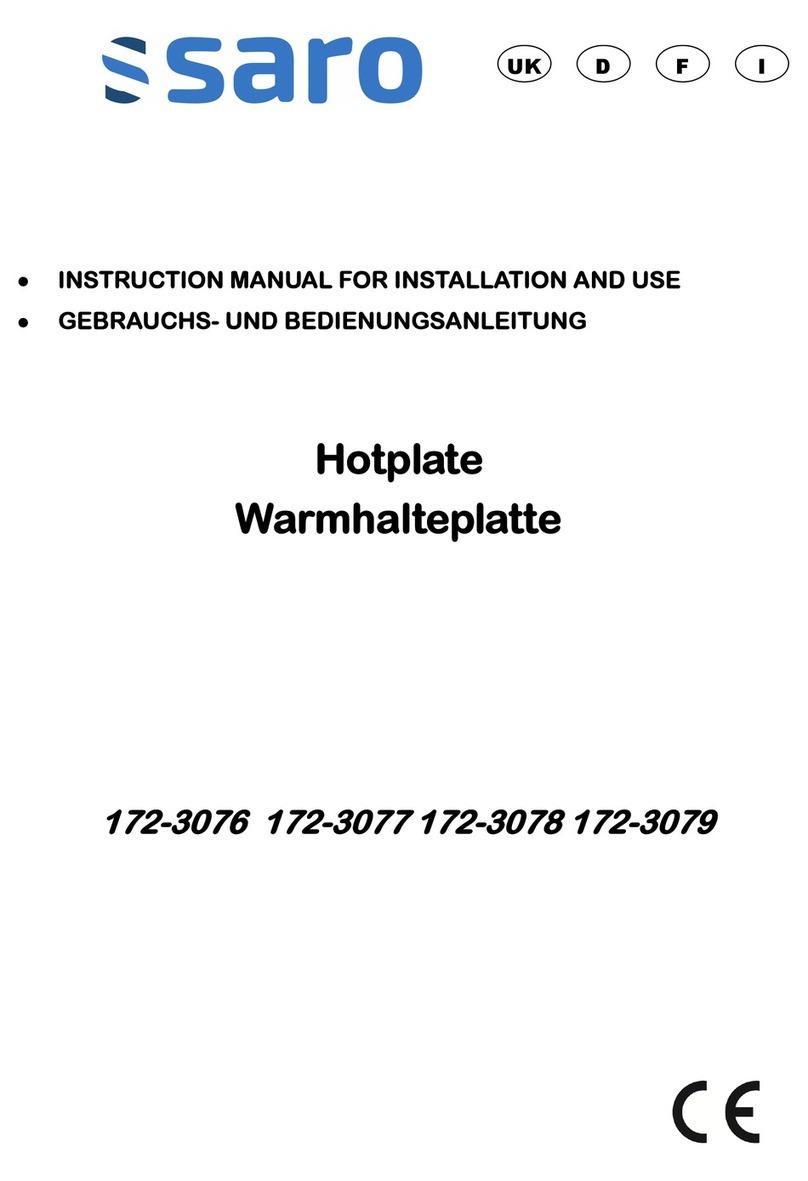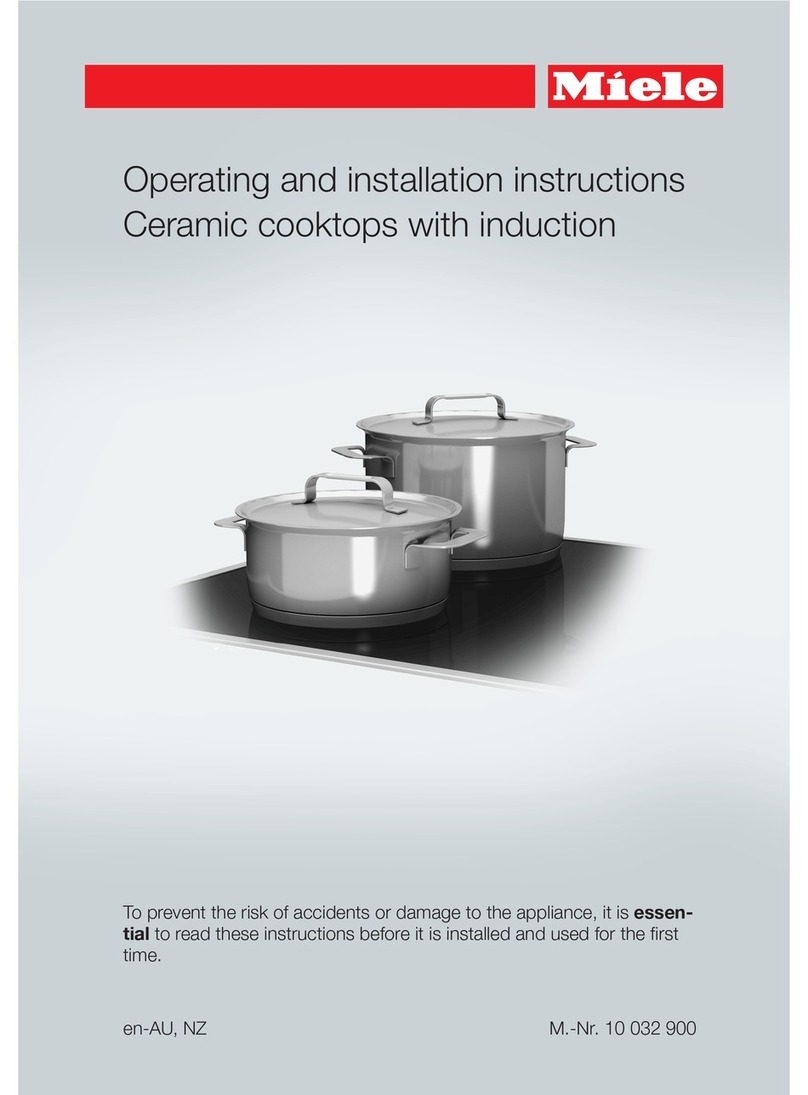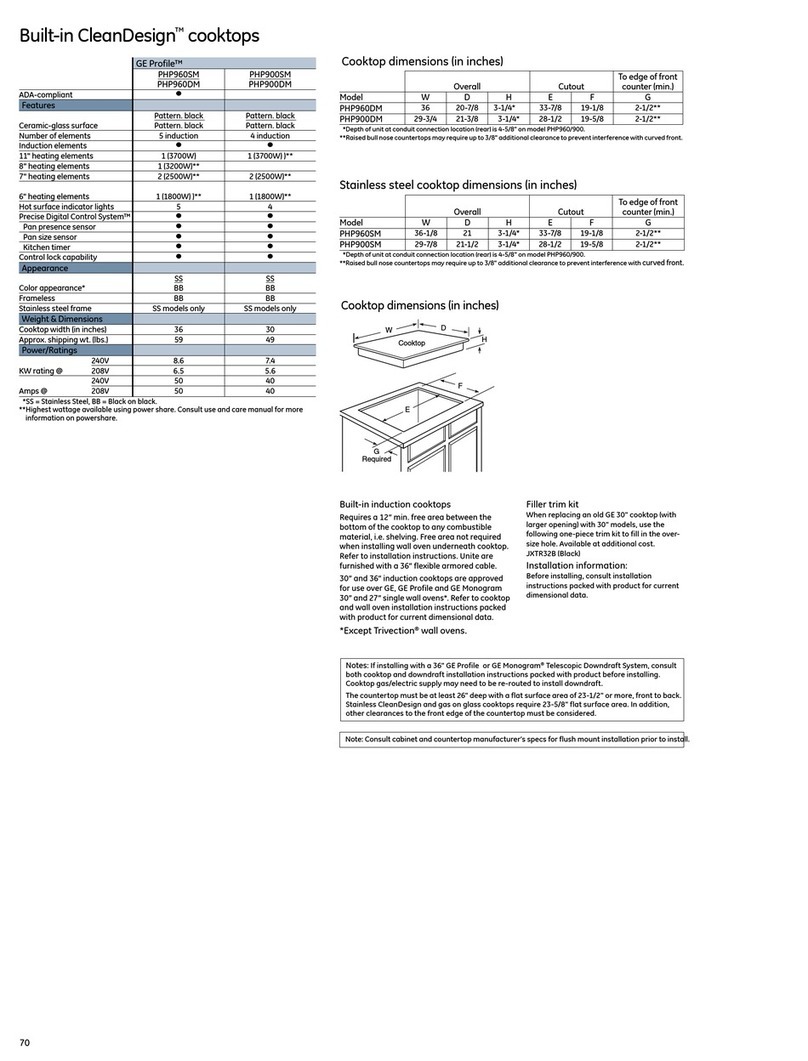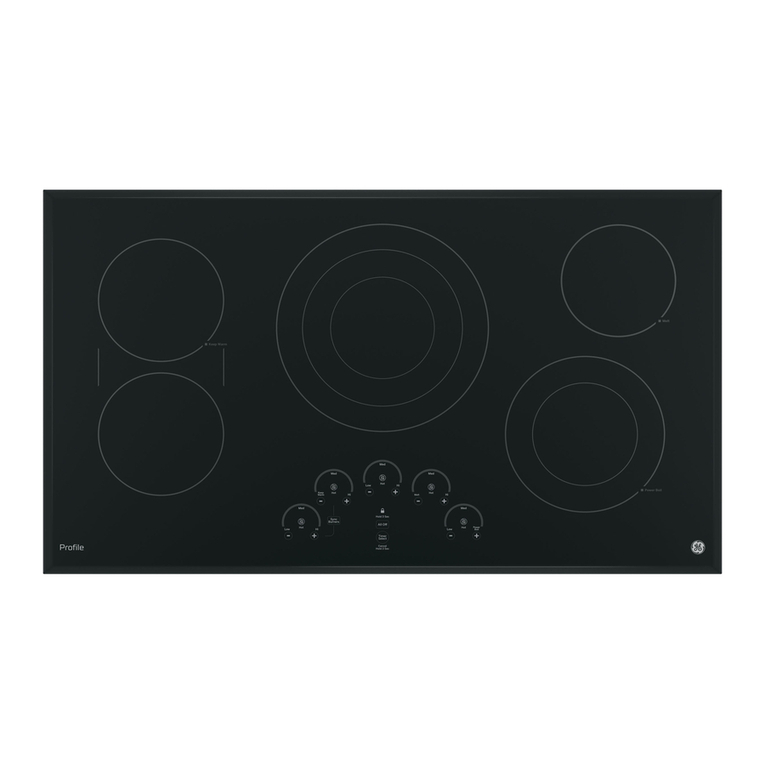Roper Gas Cooktops User manual

ZO”,
30"and36"
GasCooktops
ROPER
IMPORTANT:
Read and save
these instructions.
IMPORTANT:
Installer: Leave Installation Instructions with the appliance.
Homeowner: Keep Installation Instruti~ns for future reference.
Save Installation InstrUctions for’locd eledridinspector’s use.
Part No. 36-305986-02-O/4362941

Before you
start.. .
Proper installation is your
responsibility. Make sure you have
everything necessary for correct
installation. It is the responsibility of
the installer to comply with
installation clearances specified on
the serial/rating plate. The
serial/rating plate is located on the
bottom of the cooktop.
Check the location where the cooktop
will be installed. The location should
be away from strong draft areas, such
as windows, doors and strong,
heating vents or fans. The cooktop
should be located for convenient use
in the kitchen.
ALL OPENINGS IN THE WALL OR
FLOOR WHERE THE COOKTOP IS TO
BE INSTALLED MUST BE SEALED.
Grounded electrical outlet is
required. See “Electrical
requirements”.
Proper gas supply connection must
be available. See “Gas supply
requirements”.
IMPORTANT: Observe all
governing codes and
ordinances. Failure to meet
codes and ordinances could
lead to fire or electrical shock.
20" Cooktop
24” min. base cabinet is required. If
cabinet has a drawer, a 3-112”depth
clearance from the countertop to the top
of the drawer (or other obstruction) in
the base cabinet is required.
“‘Note: 30” min. clearance if bottom
of
wood or
metal cabinet is
protected
by not
less than -‘lame retardant
millboard
covered w.
rot less than No. 28 MSG
sheet steel, .015” stainless steel, or .024”
aluminum 02 .OZO”mpper.
36” min. clearance
between
top of
cooking
pl& and
bottom
of
unprotect6
;ood
or metal cabinet.
The clearances specified are for
combustible walls and materials
that have a density of 20 or more
pounds per cubic foot. No
evaluation of clearances has been
made for installations adjacent to
materials that are less than 20
pounds per cubic foot or to plastic
tiles and sheeting.
Countertop opening dimensions
that are shown must be used. Given
dimensions are minimum clearances
and provide the required 0”
clearance.
Mobile home installation:
The installation of this cooktop must
conform to the Manufactured Home
Construction and Safety Standards,
Title 24 CFB, Part 3280 (formerly the
Federal Standard for Mobile Home
Construction and Safety, Title 24,
HUD, Part 280), or when such
standard is not applicable, the
Standard for Manufactured Home
Installations 1982 (Manufactured
Home Sites, Communities and Set-
Ups), ANSI A225.1 -latest edition,
or with local codes.
Copies of the standards listed above
may be obtained from:
*National Fire Protection Association
Batterymarch Park
Quincy, Massachusetts 02269
**American Gas Association
1515 Wilson Boulevard
Arlington, Virginia 22209
WARNING: If the
information in this manual
is not followed exactly; a
fire or explosion may result
causing property damage,
personal injury or death.
- Do not store or use
gasoline or other
flammable vapors and
liquids in the vicinity of
this or any other appliance.
- WHAT TO DO IF YOU
SMELL GAS
. Do not try to light any
appliance.
. Do not touch any
electrical switch; do not
use any phone in your
building.
. Immediately call your gas
supplier from a neighbor’!
phone. Follow the gas
supplier’s instructions.
1 If you cannot reach your
gas supplier, call the
fire department.
- Installation and service
must be performed by a
qualified installer, service
agency or the gas supplier.
Fire Hazard
Do Not obstruct the flow of
combustion and ventilation air.
Personal Injury Hazard
Avoid installing cabinet storage
above the cooking surface. If
cabinets are already installed,
reduce the hazard of
reaching
over a heated cooking surface by
installing a range hood. The
range hood should extend a
minimum of 5 inches out from
the bottom front of the cabinets.
Reaching over a heated cooking
surface could result in a serious
bum or other personal injury.
Electrical Shock Hazard
It is the customer’s
responsibility:
n To contact a qualified electrical
installer.
n To assure that electrical
installation is adequate and in
conformance with National
Electrical Code, ANSYNFPA 70-
latest edition*, and all local
codes and ordinance.
Failure to do so could result in
fire, electrical shock or other
personal injury.
A
Read “Before you start...“, “Gas requirements” and “Electrical requirements” before
. installing cooktop.
B
Installation dimensions for the 30” cooktop are given on Panel B and for the
n
36” cooktop on Panel C.
21”min or 15” min.
cabinet width above
*__13” max. upper
cabinet depth
clearance.
upper cabinet to
countertop. I
I
i between-adjacent
cooktops.
7-l/4” min. countertop
. ,,.- space both sides of
cooktop to vertical
wall or other
combustible material.
gas line
opening - 5” below
the countertop and
centered in the
cabinet.
I
15”max from
bottom bf I I II
Do Notpinch
the power supply
cord between the \ III
For New and ReplacementFor New and Replacement
installations:installations:
3” min. space to3” min. space to
Note: The width and depth dimensions shown may be reversed to install the 20”Note: The width and depth dimensions shown may be reversed to install the 20”
cooktop in a 15” min. base cabinet. Center the opening from front to rear in the
countertop.
Do Not seal
cooktop to
countertop.
Panel A

-
30" Cooktop A
Read “Before you start...“, “
n
installing cooktop. Gas requirements” and “Electrical requirements” before
30” min. base cabinet is required. If
cabinet has a drawer, a 3-3/8” depth
clearance from the countertop to the top
of the drawer (or other obstruction) in
the base cabinet is required.
***Note: 30” min. clearance if bottom of
wood
of metal cabinet is protected by not
less than l/4” flame retardant millboard
covered with not less than No. 28 JUSG
sheet steel, .015” stainless steel, or .024”
aluminum or .020” copper.
36” min. clearance between top of
cooldng platform and bottom of
unprotected wood or metal cabinet. *** See Note for
30” min. cabinet
I -3/16” min.
cabinet space
right side of
cooktop from a
combustible
surface.
7-3116” min.
cabinet space
cooktop from a
combustible
Do Not seal
cooJftop to
countertop.
below the
countertop and
centered in the
For New and Replacement
installations:
l-3/8” min.
backsplash or
vertical wall
27-5%” min.
Width
I
19-318” min.
depth
l-9116” min.
space
to
front
edge of et
15”
max. from
bottom of
‘OUT
, DONot pinch the
Tools and
materials needed
for installation:
tape measurer
Gas supply
requirements
Important: Observe all governing
codes and ordinances.
Fire Hazard
. Cooktop must be connected to a
regulated gas supply.
. Do Not use an open flame to test
for leaks from
gas connections.
. New, A.G.A. design-certified,
flexible gas line should be used
when codes permit.
Failure to follow these
instructions could result in
a
fire,
explosion or other personal injury.
A
w This installation must conform
with local codes and ordinances. In the
absence of local codes, installations
must conform with American National
Standard, National Fuel Gas Code
ANSI 2223.1” - latest edition.
B
n
Input ratings shown on the
serial/rating plate are for elevations up
to 2,000 feet. For elevations above
2,000 feet, ratings are reduced at a rate
of 4% for each 1,000 feet above sea
level.
C
n
This cooktop is equipped for
use with NATURAL gas. It is design-
certified by A.G.A. for NATURAL and
L.P. gas with appropriate conversion.
The serial/rating plate, located on the
bottom of the cooktop, has information
on the type of gas than can be used. If
this information does not agree with
the type of gas available, see your
Roper dealer.
D
n
Provide a aas
SUDD~V
line of
314”rigid pipe to t<e coo-Gob location.
A smaller size pipe on longer runs
may result in insufficient gas supply.
Pipe-joint compounds, resistant to the
action of NATURAL and L.P. gas,
must be used.
E
n
If local codes and ordinances
permit, A.G.A.-design-certified, new
flexible metal tubing is recommended
for connecting cooktop to the to the
gas supply line. Do Not kink or
damage the flexible tubing when
moving the cooktop.
A
l/2” male pipe
thread is needed for connection to
pressure regulator female pipe
threads.
I’
n
The supply line shall be
equipped with an approved shutoff
valve. This valve should be located in
the same
room as
the
range
and
should be in a location that allows
ease of opening and closing. Do Not
block access to shutoff valve.
w If rigid pipe is used as a
gas supply fine, acombination of 111
pipe fittings must be used to obtain
an in-line connection to the cooktop.
All strains must be removed from the
supply and fuel lines so the cooktop
will be level and in line.
H
n
The regulator must be
checked at a minimum of l-inch water
column above the set pressure. The
inlet pressure to the regulator should
be as follows for operation:
NATURAL GAS:
Set pressure 7 inches
Maximum pressure 14 inches
L.P. GAS:
Set pressure 11 inches
Maximum pressure 14 inches
I
n
Line Pressure Testing:
Testing above l/2 psi (gauge) -
The cooktop and its individual shutoff
valve must be disconnected from the
gas supply piping system during any
pressure testing of that system at test
pressures greater than l/2 psig
(3.5kPa).
Testing at l/2 psi (gauge) -
The cooktop must be isolated from the
gas supply piping system by closing
its individual, manual shutoff valve
during any pressure testing of the gas
supply piping system at test
pressures equal to or less than l/2
psig (3.5kPa).
Panel B

36” Cooktop A
Read “Before you start...“, “Gas requirements” and “Electrical requirements” before
n
installing cooktop.
36” min. base cabinet is required. If
cabinet has a drawer, a 5-W’ depth
clearance from the countertop to the top
of the drawer (or other obstruction) in
the base cabinet is required.
***Note: 30” min. clearance if bottom of
wood or metal cabinet is protected by not
less than l/rl”dame retardant millhoard
covered with not less than No. 28 MSG
sheet steel, .015” stainless steel, or .024”
aluminum or .020” copper.
36” min. clearance between top of
cooking platform and bottom of
unprotected wood or metal cabinet.
13” max. upper
3” min. countertop
space both sides
vertical wall or
other combustible
Do Not seal
cooktop to
countertop.
opening - 5”
below the
countertop and
centered in the
cabinet.
Wall receptacle -
32” max.
horn
right
side of cooktop.
15”max &om
bottom bf
countertop.
the cooktop and
cabinets.
For New and Replacement
installatl----.
ions:
*
8 Z-7/4” min.
i.
’ cabinet space to I
iF backsplash or 1
vertical wall
A 120~volt, 60-Hz, AC-only, 15- or 20-
ampere, fused electrical supply is
required. A time-delay fuse or circuit
breaker box is recommended. It is
recommended that a separate circuit
serving only this appliance be
provided.
Electronic ignition systems operate
within wide voltage limits, but proper
grounding and polarity is necessary.
In addition to checking that the outlet
provides 120~volt power and is
correctly grounded, the outlet must be
checked by a qualified electrician to
see if it is wired with correct polarity.
Recommended grounding
method
For your personal safety, this
appliance must be grounded. This
appliance is equipped with a power
supply cord having a 3-prong
grounding plug. To minimize possible
shock hazard, the cord must be
plugged into a
mating
3-prong
grounding-type wall receptacle,
grounded in accordance with National
Electrical Code, ANSUNFPA 70-latest
edition* and all local codes and
ordinances. See Figure 1. If a mating
wall receptacle is not available, it is
the personal responsibility and
obligation of the customer to have a
properly grounded 3-prong wall
receptacle installed by a qualified
electrician.
Electrical
requirements
J-prong
grounding
type wall
d-prong
grounding
Electrical Shock Hazard
n
Electrical ground is required on
this appliance.
. Do Not ground to a gas pipe.
n Do Not modify the power supply
cord plug. If it does not fit the
outlet, have a proper outlet
installed by a qualified
electrician.
. Do Not have a fuse in the neutral
or grounding circuit. A fuse in
the neutral or grounding circuit
could result in an electrical
shock.
mDo Not use and extension cord
with this appliance.
. Check with a qualified
electrician if you are in doubt as
tc whether the appliance is
properly grounded.
Failure to follow these instructions
could result in serious injury or
death.
power supply
cord
Figure 1
Lfcodes permit and a separate
grounding wire is used, it is
recommended that a qualified
electrician determine that the
grounding path is adequate.
See Panel E for wiring diagram.
Panel C

Now start
With
cooktop
in kitchen.
Determine which mounting
method you will use. Refer
to Steps 5, 6 and 7.
Personal Injury Hazard
7
If countertop material is
a
Assemble the flexible
I
w difficult to drill through (such g
n
connector from the gas supply
as ceramic): (Wood screws or nails pipe to the pressure regulator m order:
may not be supplied.) manual shutoff valve, l/2” nipple, l/2”
adapter, flexible connector, inn
adapter, and l/2” nipple.
Wear protective eyeglasses when
Property Damage
Lift entire cooktop up from cutout
when repositioning cooktop in
countertop opening.
Failure to do so could scratch
countertop.
5
If the burner box flange will
w be screwed directlv into the
A.
Use a carbide tip drill bit to drill
clearance holes through the countertop
material at.each mark.
countertop: (Mounting screws may not
be supplied with all models.)
1
Remove shipping materials,
tape, and protective film from
n
cooktop.
B.
A.
\
manual
shutoff
valve
pressure
regulator
2
Remove the burner grates
w control knobs and ariddle cover
Drill pilot holes at each mark for the
screws. Reset cooktop into cutout and align
mounting holes with the drilled
clearance holes.
(if available for your model)from the
B.
Reset cooktop into cutout and align
mounting holes with the pilot holes. Product Damage
Do Not hit burner box flange with
hammer.
Hitting the flange with the hammer
could damage the porcelain finish.
C.
Lower cooktop into operating position.
Lift cooktop up to at least a 90” angle
and support the cooktop securely.
Insert a wood screw in each of the front
wood
and rear corner mounting holes to
fasten burner box flange to countertop.
(Some cooktops may have a mounting
screw
hole in the center of the front and rear
flanae L
flanges. Use of center mounting holes
is optional.) Do Not overtiahten screws.
Fire Hazard
Do Not make connection too tight.
The regulator is die-cast.
Overtightening may crack the
regulator, resulting in a gas leak
and possible fire or explosion.
C.
Lift cooktop up to at least a 90” angle
and support the cooktop securely. Use
a wood screw or flat-head nail through
each of the front and rear comer
mounting holes to fasten burner box
flange to countertop. (Some cooktops
may have a mounting hole in the center
of the front and rear flanges. Use of
center mounting holes is optional.) Do
Not overtighten screws or hammer nails
too tightly to countertop. Lower
cooktop into operating position.
.
10
Use pipe-joint compound
n
resistant to the action of
NATURAL and L.P. gas to seal all qas
connections. If flexible connectors-are
used, be certain connectors are not
kinked.
cooktop. Remove parts from bag and
3
line up next to your tools.
Remove the plastic, parts bag
n
(if supplied) from inside
11
Open the shutoff valve m
n
the gas supply ’ - Walt a
Optional method: Bolts at least 2-l/2
tithes long (available from a local
rdware store) can be used,
uepending on the location of the
cooktop mounting holes. few minutes for the g&t6 I, ie
through the gas line.
I
I
n
top opening. *Center cooktop in
cutout. Check that the front of the
cooktop is parallel to the front edge of
the countertop. Check that all required
clearances are met. Lift UDcooktor, and
Insert
CcoktoD
into the counter- \\\
8
Remove the shipping screws
w from the burners.
mark location of mounting holes on I
countertop. Remove cooktop from rear
mounting
cutout.
holes
I
front
mounting
holes
Fire Hazard
Do Not use an open flame to check
for leaks from gas connections.
Checking for leaks with a flame
may result in a fire or explosion.
6
If the burner box will be
n
nailed directly into the
countertop: (Flat-head nails are not
supplied.)
12
Use a brush and liquid
. detergent to test all gas
connections for leaks. Bubbles around
connections will indicate a leak. If a
leak appears, shut off the valve controls
A.
Drill pilot holes at each mark for the
nails. and adjust connections. Then check
h GASLEAKSWITHAMATCHOR
connectlons again. NEVER TEST FOR
OTHER FLAME. Clean all detergent
solution from cooktop.
B.
Reset cooktop into cutout and align
mounting holes with the pilot holes.
All connections must be
wrench-tightened.
Product Damage
Do Not hit burner box flange with
hammer.
Hitting the flange with the
hammer could damage the
porcelain finish.
C.
Lift cooktop up to at least a 90” angle
and support the cooktop securely.
Hammer a flat-head nail through each
of the front and rear corner mounting
holes to fasten burner box flange to
countertop. (Some cooktops may have a
mounting hole in the center of the front
and rear flanges. Use of center
mounting holes is optional.) Do Not
hammer nails too tightly to countertop.
Lower cooktop into operating position.
13
Plug the electrical cord into
n
the grounded outlet.
Panel D

14
Place the burner grates
w over the burners and caps.
-
Place the cover on the griddle (if
available). Install the control knobs on
the valve stems.
Electronic ignition Standing pilot
system - initial svstem
lighting
“OFF” position. Raise the cooktop. Use
a match to light both pilots. Adjust
pilot adjustment screw so pilot flame
tip is l/4” to 3/S” high and centered in
the hole in the pilot housing. If the
flame is too high, carbon (soot) will
accumulate under the cooktop.
Cooktop burners use electronic igniters
in place of standing pilots. When the
cooktop control knob is turned to the
“LlTE” position, the system creates a
spark to light the burner. This sparking
continues until the control is turned to
the desired setting.
Check the operation of the
cooktop burners. Push in
and turn each control to the “LITE”
position. The flame should light within
4 seconds.
Do not leave the knob in the “LITE”
position after the burner lights.
16
A
9 Check the operation
n
of the cooktop
burners. Push in and turn each control
knob to “LlTE” position.
The flame should
light within 4
seconds. Do not
leave the knob in
the “LITE”
position after
burner lights.
17.
A .
After burner lights, turn control knob to
“HI” position. Check each cooktop
16
After the burner lights, inner cone should have a very distinct
w turn the control knob to the blue flame l/4” to l/2” long.
The outer cone is not as
“HI” position. Check that the burner
flame has a small, inner cone with a -distinct as the
nner cone.
burner for proper flame. The small
very distinct, blue flame that is l/4” to
l/2” long. The outer cone is not as
distinct as the Inner cone. m
If the burners need adjusting, loosen
the shutter screw. Adjust the air
shutter. Closing the air shutter will
cause a soft, yellow-tipped flame.
Opening the air shutter will cause
lifting or blowing of the flame from the
burner. After adjusting a shutter,
18.
A .
If burners need
adjusting for proper
tighten the shutter screw. Repeat for flame, adjust the air shutter to the
widest opening that will not cause the
flame to lift or blow off of the burner.
Repeat as necessary with each burner.
17
w Push in and turn the control
knob to the “LITE” position and then
to the low position, The low flame
19.A.
Repeat Step 17.
should be a minimum, steady, blue
flame. To adjust the burner, remove
the control knob and turn the
adjustment screw in the center of the
valve stem. Check the adjustment by
turning the control knob from “HI” to
low several times. The burner is
properly adjusted when the low flame
remains steady and the burner does
not go out. Check each burner.
I-,
Congratulations!
You have just finished
installing your new,
Roper cooktop. Keep
Installation Instructions
available for easy
reference.
Wiring
diagrams
The power cord on this appliance is
equipped with a three-pronged
(grounding) plug which mates with
standard, three-pronged (grounded)
wall receptacles.
20” gas models
SWIlCWES
l-T!!-
IGNIIER
4-w
SCHEMATIC
30” gas models
NOTE: WIRES TO BE REPLACED MUST HAVE
SAME INSULATION 8 TEMPERATURE
RATING AS ORIGINAL WIRES SUPPLIED
WITH APPLIANCE.
120 V.A.C.
SPARK IGNITORS
, FRONT REAR
SPARK
MODULE
36” gas models
SURFACE
BURNER
ELECTRODES I ,
PC0
SPARK
MODULE
Panel E

L.P. Gas Conversion
Converting to L.P. gas should be done
by a qualified installer.
Natural
I
L.P.
Pressure Regulator: Use a wrench to
unscrew the cap from the top by
turning counter-clockwise. Turn the
cap over so the hole end is up.
Replace the cap and gasket on the
regulator. DO NOT REMOVE THE
PRESSUREREGULATOR.
A
Only a qualified installer should
. install or adjust your gas range.
B
Cooktop Burners: Turn the
. orifices hood down until snug
against pin. DO NOT OVERTIGHTEN.
Adjust the air shutters for proper flame
by sliding the air shutter to close or
open the shutter as needed. See
Panel E, Step 16 for electronic ignition
systems and Panel E, Steps 17A and
18A for standing pilot systems.
L.P. GAS
NATLTRAL
GAS
HOOD
C
n
After all the burners have
been converted to L.P. gas usage
and gas line is connected, check for
leaks. Use a brush and liquid
detergent to test all gas
connections for leaks. Bubbles
around connections will indicate a
leak. If a leak appears, shut off gas
valve controls and adjust
connections. Then check
connections again. NEVER TEST
FOR GAS LEAKS WITH A MATCH
OR OTHER FLAME.
Cooktop burners with standing pilots
require adjustment of pilot flame to l/4” /-
high. The adjustment control is located
on the manifold pipe or at pilot flame
base depending on the model.
- TM
ROPER
Part No. 36-305986-02-O/4362941
01992 Benton Harbor, Michigan 49022
If cooktop does not
operate...
Check that the circuit breaker is not
tripped or fused blown. Check that the
power supply cord is plugged into the
wall receptacle. Check that gas valves are
turned to the “ON” position.
A more detailed troubleshooting checklist
is provided in the Use and Care Guide.
NOTE: Refer to Use and Care Guide for
operating instructions and cleaning
instructions.
If you need
assistance...
The Roper Consumer Assistance Center
will answer any questions about
operating or maintaining your appliances
not covered in the Installation
Instructions. The Roper Consumer
Assistance Center is open 24 hours a
day, 7 days a week. Just dial (800) 447-
6737
- the call is free.
When you call, you will need the
appliance model number and serial
number. Both numbers can be found on
the serial/rating plate located on the
bottom of the cooktop.
If you need
service.. .
In the event that your Roper appliance
should need service, call the dealer from
whom you purchased the appliance or a
Roper-authorized service company. A
Roper-authorized service company is
listed in the Yellow Pages of your
telephone directory under “Appliances
- Household - Major - Service of
Repair”. You can also obtain the service
company’s name and telephone number
by dialing, free, within the continental
United states, the Roper Consumer
Assistance Center telephone number,
(800) 447-6737. A special operator will
tell you the name and number of your
nearest Roper-authorized service
company.
Printed in U.S.A.
Table of contents
Other Roper Cooktop manuals
Popular Cooktop manuals by other brands
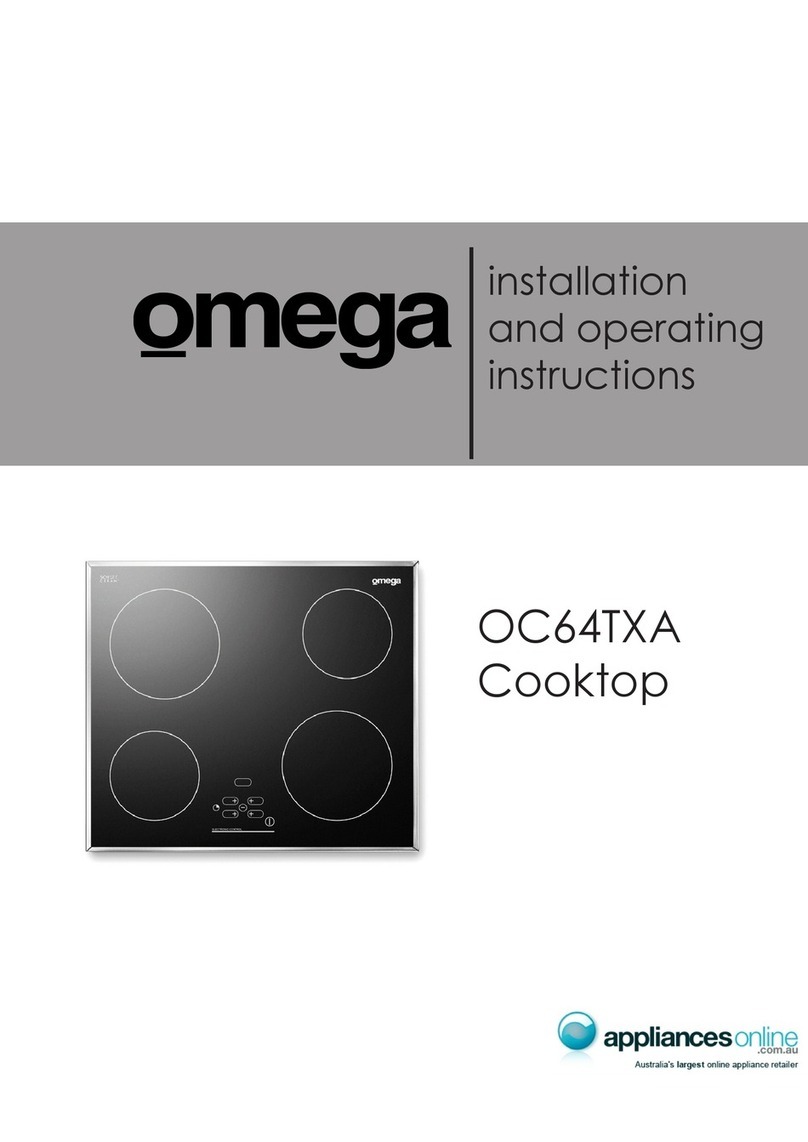
Omega
Omega OC64TXA Installation and operating instructions
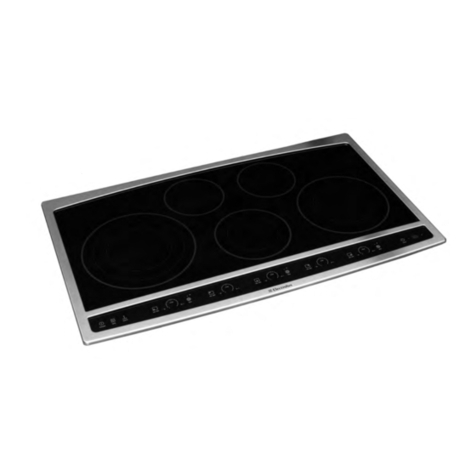
Electrolux
Electrolux 36" Ceramic Use and care guide
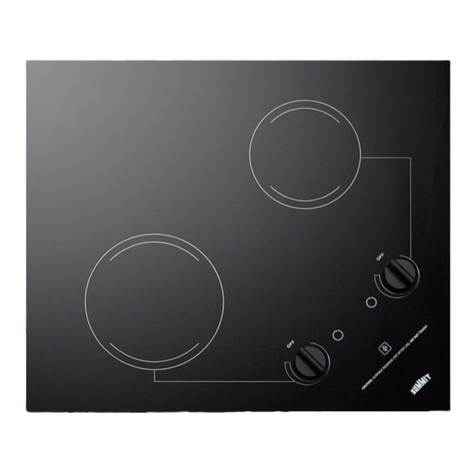
Felix Storch
Felix Storch Summit CR2B223G owner's manual
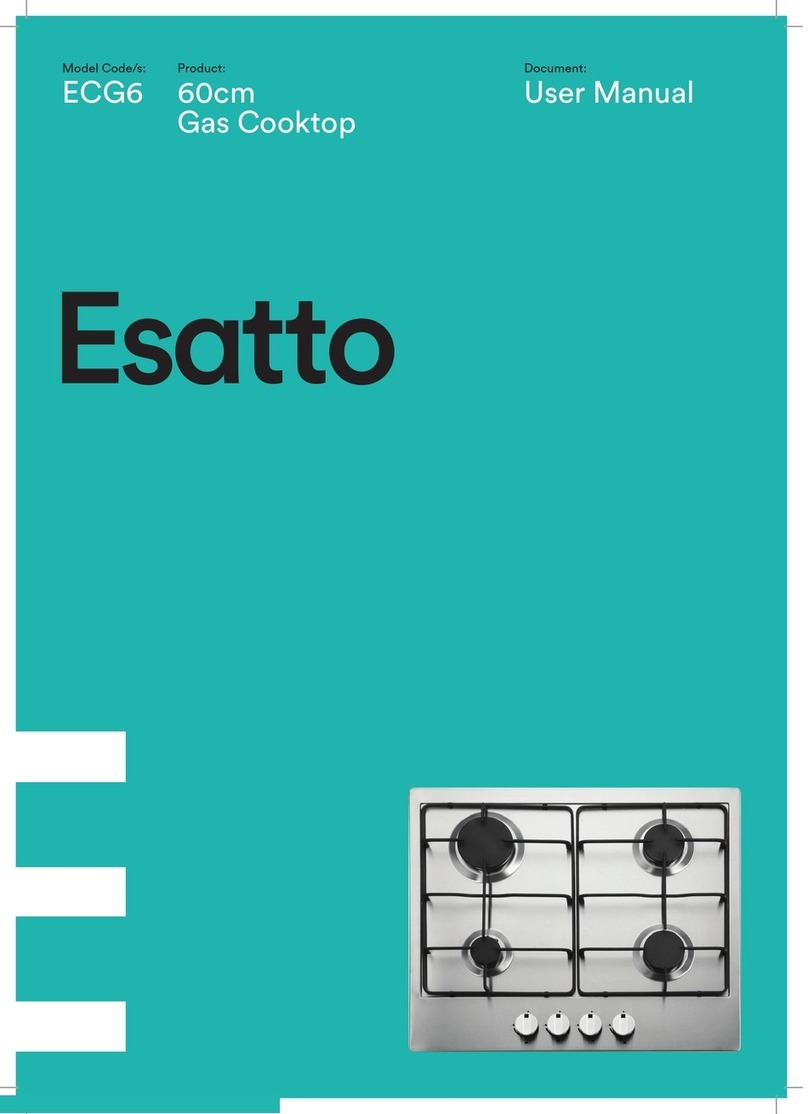
Residentia
Residentia ESATTO ECG6 user manual

GE
GE Monogram ZHU30RSR Dimension Guide
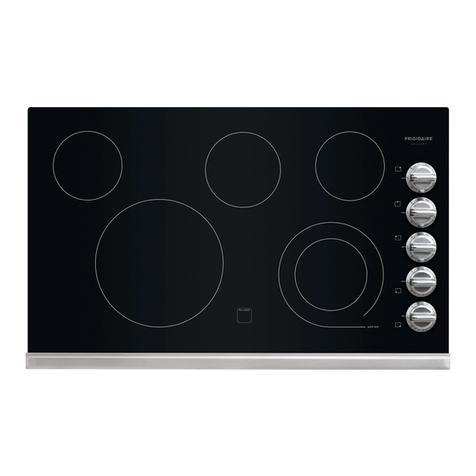
Electrolux
Electrolux EI24EC15KS installation instructions





